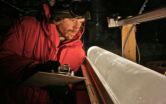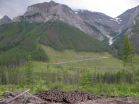(Press-News.org) This press release is available in French.
Montreal, March 7, 2013 – Just hours after the tragic shooting of 27 victims at Sandy Hook Elementary School, Twitter was overloaded with messages slamming reporters for interviewing children involved in the tragedy. While some of the journalists probably knew better but wanted the story at all costs, others were rookie reporters facing ethical decisions for the first time and unaware of the impact these interviews might have on the young survivors.
Past studies have documented that new journalists can cause a number of problems at the scene because a lack of sensitivity can lead to unnecessary intrusions, thus further traumatizing victims. But research from Concordia University proves that journalism students can be prepared for these ethical issues before they must face the shock of a real event.
The new study by Concordia researchers Elyse Amend, Linda Kay and Rosemary Reilly, published in the Journal of Mass Media Ethics, proves that simulation is an effective training tool that can teach rookies ethical behaviour before they must handle a traumatic event.
Linda Kay, who chairs Concordia's Department of Journalism, first presented the idea of using simulation as journalism training at a conference in 2008. "Educators were very interested in the idea and wanted more information about how it would work," she recalls. Study co-author Rosemary Reilly, an associate professor in Concordia's Department of Applied Human Sciences notes that "this is a perfect example of the interrelationship between research and teaching – how one informs the other and vice versa."
To find suitable guidelines for a simulation experience, the research team first set out to find what kind of ethical issues face reporters working in the field today. They created a focus group of seven Canadian journalists working in TV, radio and print with experience ranging from three to 30 years.
These reporters highlighted the four major ethical decisions they commonly face at distressful or traumatic events: understanding their role at the scene; getting the story vs. respecting needs of victims; learning the limits of meeting job obligations; and properly navigating on-the-job training.
Though simulations are not new as a teaching tool, they have been rarely used with journalism students. In their study, Amend, Kay and Reilly identify specific guidelines to ensure these simulations would actually create believable events that young reporters might face on the job.
At one such simulation experience where participants had to report on an Art Gallery fire, one student remarked afterwards: "I would have to say in all honesty that it was the best two hours of university I've had yet."
Classroom simulations give budding journalists a safe place to explore the ethical issues they might face on the job and to try out different behaviors and their consequences.
"There's a growing awareness in the journalism teaching profession that students need more preparation," say Kay. "Trauma is such a huge issue now and it can be harmful to all if a young journalist is just thrown into the situation to learn on the job."
###
More on the researchers: Linda Kay is the Chair of the Department of Journalism at Concordia University; Rosemary Reilly is an associate professor in Concordia's Department of Applied Human Sciences; Elyse Amend earned an MA in Journalism Studies from Concordia University in November 2011.
Related links:
Department of Journalism http://journalism.concordia.ca/
Department of Applied Human Sciences http://ahsc.concordia.ca/
Linda Kay's Research @ Concordia Profile http://www.concordia.ca/explore/#!/profile/2411/
Rosemary Reilly's Research@ Concordia Profile http://www.concordia.ca/explore/#!/profile/3891/
Media contact:
Cléa Desjardins
Senior Advisor, External Communications
Concordia University
Tel: 514-848-2424, ext. 5068
Cell: 514-909-2999
e-mail: clea.desjardins@concordia.ca
Web: concordia.ca/media-relations
Twitter: twitter.com/CleaDesjardins
Trauma simulation technique makes better journalists
Concordia research proposes unique approach to help rookie reporters cover traumatic events
2013-03-08
ELSE PRESS RELEASES FROM THIS DATE:
Hubble finds birth certificate of oldest known star
2013-03-08
A team of astronomers using NASA's Hubble Space Telescope has taken an important step closer to finding the birth certificate of a star that's been around for a very long time.
"We have found that this is the oldest known star with a well-determined age," said Howard Bond of Pennsylvania State University in University Park, Pa., and the Space Telescope Science Institute in Baltimore, Md.
The star could be as old as 14.5 billion years (plus or minus 0.8 billion years), which at first glance would make it older than the universe's calculated age of about 13.8 billion ...
Small physician practices that care for children unprepared to become medical homes
2013-03-08
Ann Arbor, Mich. — Primary care practices around the country are being encouraged and even paid to become "medical homes," but small practices might be at a significant disadvantage in this race to improve health care for children, according to a new study by child health experts at C.S. Mott Children's Hospital.
Efforts around the country to improve health care for children have increasingly focused on the medical home as a model to make primary care practices more accessible, comprehensive, and focused on quality improvement. Since 2008, practices could become officially ...
Biologists produce rainbow-colored algae
2013-03-08
What can green algae do for science if they weren't, well, green?
That's the question biologists at UC San Diego sought to answer when they engineered a green alga used commonly in laboratories, Chlamydomonas reinhardtii, into a rainbow of different colors by producing six different colored fluorescent proteins in the algae cells.
While fluorescent green, red, blue and yellow may be all the rage this year for running shoes and other kinds of sporting gear, fluorescent algae hasn't been a style trend yet in scientific laboratories. But in announcing their achievement in ...
Stocking Florida bass in Texas reservoirs may alter stream systems connected to stocked reservoirs
2013-03-08
WACO, Texas (March 7, 2013) - A genetic analysis by Baylor University biologists suggests that the stocking of Florida bass in Texas reservoirs impacts bass populations far beyond the actual stocking location.
The native largemouth bass has a long and nearly continuous stocking history in Texas. However, the Florida bass is widely considered a better sport fish because it grows to a greater size. Subsequently, stocking efforts in Texas reservoirs have transitioned from largemouth bass to Florida bass.
The Baylor researchers analyzed the genetic composition of 69 largemouth ...
Net advantage
2013-03-08
Malaria, the leading cause of death among children in Africa, could be eliminated if three-fourths of the population used insecticide-treated bed nets, according to a new study from the National Institute for Mathematical and Biological Synthesis (NIMBioS).
The study, which uses a mathematical model, found that use of insecticide-treated bed nets or ITNs positively affected the infection's reproduction number, or R, which is the primary epidemiological number used to determine the degree which a disease can spread through a population. The model concludes that if 75 percent ...
NASA provides satellite views of Nor'easter on March 7, 2013
2013-03-08
VIDEO:
This animation of NOAA GOES-13 satellite imagery from March 5-7, 2013, shows the progression of a cold front from the west associated with a low pressure system that brought snow...
Click here for more information.
The merging of two low pressure areas into a large Nor'easter on March 6 brought winter weather advisories and warnings to the Mid-Atlantic. NASA's Aqua satellite captured an infrared and near infrared image of the storm's power, and NASA created an animation ...
Pan-STARRS finds a 'lost' supernova
2013-03-08
The star Eta Carinae is ready to blow. 170 years ago, this 100-solar-mass object belched out several suns' worth of gas in an eruption that made it the second-brightest star after Sirius. That was just a precursor to the main event, since it will eventually go supernova.
Supernova explosions of massive stars are common in spiral galaxies like the Milky Way, where new stars are forming all the time. They are almost never seen in elliptical galaxies where star formation has nearly ceased. As a result, astronomers were surprised to find a young-looking supernova in an old ...
Earth is warmer today than during 70 to 80 percent of the past 11,300 years
2013-03-08
With data from 73 ice and sediment core monitoring sites around the world, scientists have reconstructed Earth's temperature history back to the end of the last Ice Age.
The analysis reveals that the planet today is warmer than it's been during 70 to 80 percent of the last 11,300 years.
Results of the study, by researchers at Oregon State University (OSU) and Harvard University, are published this week in a paper in the journal Science.
Lead paper author Shaun Marcott of OSU says that previous research on past global temperature change has largely focused on the ...
UTHealth research: Low incidence of venous insufficiency in MS
2013-03-08
HOUSTON – (March 7, 2013) – Results of a study using several imaging methods showed that CCSVI (chronic cerebrospinal venous insufficiency) occurs at a low rate in both people with multiple sclerosis (MS) and non-MS volunteers, contrary to some previous studies. The research by an interdisciplinary team at The University of Texas Health Science Center at Houston (UTHealth) was published in a recent early online edition of the Annals of Neurology.
"Our results in this phase of the study suggest that findings in the major veins that drain the brain consistent with CCSVI ...
'Climate-smart strategies' proposed for spectacular US-Canadian landscape
2013-03-08
A new report from the Wildlife Conservation Society Canada (WCS Canada) creates a conservation strategy that will promote wildlife resiliency in the Southern Canadian Rockies to the future impacts of climate change and road use. The report's "safe passages and safe havens" were informed in part by an assessment of six iconic species—bull trout, westslope cutthroat trout, grizzly bears, wolverines, mountain goats and bighorn sheep—five of which were ranked as highly vulnerable to projected changes.
Nestled between Glacier National Park in Montana and Banff National ...
LAST 30 PRESS RELEASES:
Australian team discover why quantum computers have memory problems over time
What determines the fate of a T cell?
Candida auris: genetic process revealed which could be treatment target for deadly fungal disease
Groundbreaking discovery turns household plastic recycling into anti-cancer medication
Blocking a key inflammatory pathway improves liver structure and vascular function in cirrhosis, study finds
Continuous spread: Raccoon roundworm detected in nine European countries
HKUST Engineering researchers developed a novel photodetector to enhance the performance of on-chip light monitoring
Strategic river sensors could have forewarned of Texas Camp flood disaster
Drone sampling of whale breath reveals first evidence of potentially deadly virus in Arctic
Roman soldiers defending Hadrian’s Wall infected by parasites, study finds
Pinochet’s prisoners were tormented with music but still found solace in it, a new book reveals
Fertility remains high in rural Tanzania despite access to family planning
AI-assisted device can improve autism care access
Kinetic careers
Uncovering how parasitic plants avoid attacking themselves to improve crop resistance
Nanoparticle vaccine strategy could protect against Ebola and other deadly filoviruses
Study finds brain care score can predict risk of stroke across racial groups
Key lung immune cells can intensify allergic reactions
Do hormones explain why women experience more gut pain?
New materials conduct ions in solids as easily as in liquids
Breakthrough of the Year: Renewable energy begins to eclipse fossil fuel-based sources
LLM use is reshaping scientific enterprise by increasing output, reducing quality and more
Introducing LightGen, a chip for ultra-fast, ultra-efficient generative AI
Astronomers see fireworks from violent collisions around nearby star
ACC/AHA issue new guideline on managing congenital heart disease in adults
Cosmic crash caught on camera
Is talented youth nurtured the wrong way? New study shows: top performers develop differently than assumed
Ants: An untapped resource in the development of antibiotics?
Archaeologists use AI to create prehistoric video game
Mitochondria migrate toward the cell membrane in response to high glucose levels
[Press-News.org] Trauma simulation technique makes better journalistsConcordia research proposes unique approach to help rookie reporters cover traumatic events



